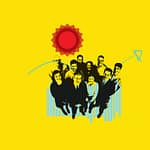The critical components of a truly effective culture were discussed in a strategy+business article. The article encourages organisations to focus on the elements of your culture to drive performance. Southwest Airlines is quoted where senior leaders pick up paintbrushes to turn bland walls into electric blue workspaces. The company’s ’40-year culture is still going strong and is further invigorated by traveling teams who volunteer every year to visit hundreds of employees to show their appreciation. And it’s infectious.’ It goes onto say how once in a while senior leaders give flight attendants time off and bags of snacks whilst they sweep the airlines inbetween flights.
Companies with the most effective culture seek out and continually reinforce what Charles Duhigg, author of The Power of Habit: Why We Do What We Do in Life and Business (Random House, 2012), calls “keystone habits.” A keystone habit, Duhigg has noted, is “a pattern that has the power to start a chain reaction, changing other habits as it moves through an organisation.” Companies that recognise and encourage such habits stand to build cultures with influence that goes beyond employee engagement and directly boosts performance.
Strategy + Insight through various cultural interventions have found organisations like HP and Bell Canada to major enterprises in India, Australia, and the Middle East, companies that portray all-encompassing culture change initiatives focus on three specific elements—critical behaviors, existing cultural traits, and critical informal leaders—have the most success. We call these “the critical few.”
Critical behaviours are described as ‘those ways of doing things in your current operations that can easily spread from one employee to another; they have the potential to generate a real business impact, particularly when they become habitual and widespread. Moreover, you would recognise them right away if respected leaders at various levels throughout the organisation started putting them into practice.’
The article states the second “critical few” as existing cultural traits, which are three or four emotional elements of the current culture that are distinctively clear, wisely profound, emotionally powerful, and widely recognised; these traits together are a manifestation of the organisation’s collective sense of identity. They play a prominent role in supporting the most important behaviours.
Critical informal leaders are those few authentic individuals who motivate others by what they do and how they do it. They are recognised by their colleagues as credible, trustworthy, and effective—and they know how to influence behaviour.
Read the full insightful article here for a deeper explanation of the critical few components required for an effective engaging organisation.
Illustration by Grant Snider.
The above content is not owned by Engage for Success and has been extracted from an article originally published by strategy+business.




